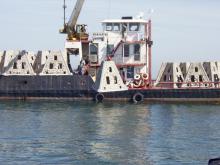Information Possibly Outdated
The information presented on this page was originally released on June 25, 2009. It may not be outdated, but please search our site for more current information. If you plan to quote or reference this information in a publication, please check with the Extension specialist or author before proceeding.
Artificial reefs may help restore red snapper stocks
By Jason Brandt and Karen Brasher
MSU College of Forest Resources
MISSISSIPPI STATE -- The red snapper has proven to be an economically and culturally important fish species, but their numbers are declining throughout the Gulf of Mexico and the Atlantic.
To help address this problem, Mississippi State University scientists, in collaboration with the Mississippi Department of Marine Resources, are examining how artificial reefs might slow red snapper decline and assist in its recovery.
Fishing for red snapper in the Gulf of Mexico is an important commercial venture and an exciting recreational pursuit. Commercial fisheries contribute approximately $40 million to the Gulf Coast economy, and more than 500,000 anglers participate in recreational saltwater fishing in Alabama, Mississippi and Louisiana, according to a 2006 survey by the U.S. Fish and Wildlife Service. Anglers provide income to Gulf Coast states through trip-related expenditures, including food, lodging, transportation and equipment.
“In the last two decades, red snapper stocks are estimated to have declined by as much as 90 percent in the northern Gulf of Mexico,” said Don Jackson, professor and fisheries biologist at MSU’s Forest and Wildlife Research Center.
Overfishing and high juvenile by-catch mortality in the shrimp trawl industry are most likely to blame for the red snapper stock reduction, Jackson said. Commercially, red snapper are typically caught with multi-hook gear and reels or shrimp trawls.
MSU’s research is particularly important as the Mississippi Gulf Coast works to recover its fisheries after Hurricane Katrina. During that storm, many of the artificial reefs that were in place and functioning along the coast were destroyed.
“The use of artificial reefs is not a new concept,” Jackson said. “They have been employed for the last 20 years in the northern Gulf of Mexico to enhance Gulf fisheries and fish stocks.”
The ideal placement of artificial reefs has not been previously addressed on the Mississippi Gulf Coast.
“The reefs provide a place of refuge and forage for reef fish like red snapper,” Jackson said. “We believe that artificial reefs may play an important role in enhancing fisheries targeting red snapper. What we don’t know is how the placement or design of these reefs affect red snapper stocks.”
To determine the best placement of artificial reef structures, wildlife and fisheries graduate student Jason Brandt has been working with fisheries biologists in the Mississippi Department of Marine Resources.
“We have been placing artificial reef material, such as concrete rubble and decommissioned shrimp boats, in the coastal waters off of Mississippi for a number of years without giving much thought to how we were placing the material and how that might affect our desired results,” said Kerwin Cuevas, head of the Artificial Reef Bureau at the department. “Now we are trying to determine which pattern of artificial reefs will provide the best habitat for juvenile red snapper.”
Researchers are testing four different patterns for placement of pyramid-shaped artificial reefs. The different patterns address reef spacing and horizontal extension. So far, researchers have completed 26 sampling trips on the reefs that have been placed in various experimental configurations. They use baited fish traps to collect samples.
“We have collected 927 juvenile red snapper, which is fantastic. Juvenile red snapper are attracted to the structures and using them for foraging and refuge,” Cuevas said.
From the recaptures of tagged red snapper, Cuevas said it is evident that once the fish go to the structures, they are staying there. Whether a particular reef pattern is best at recruiting juvenile red snapper is yet to be determined, but the researchers said they are optimistic about their initial findings.
“Hopefully, we will see these juvenile red snapper that have relocated to the structures staying there to grow to spawning size and aid in the rehabilitation of red snapper stocks in the northern Gulf of Mexico,” Cuevas said.



